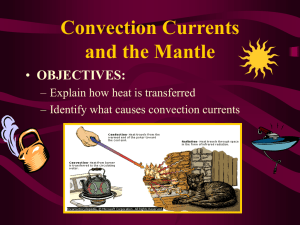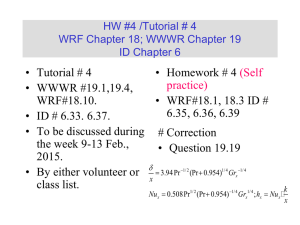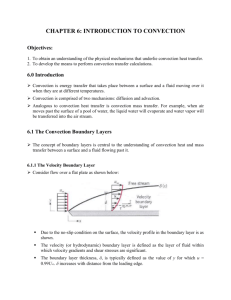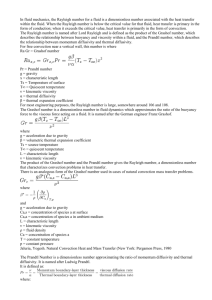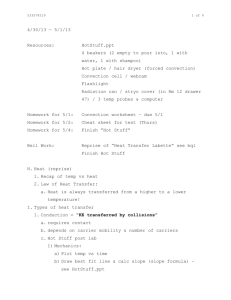Natural or Free Convection
advertisement
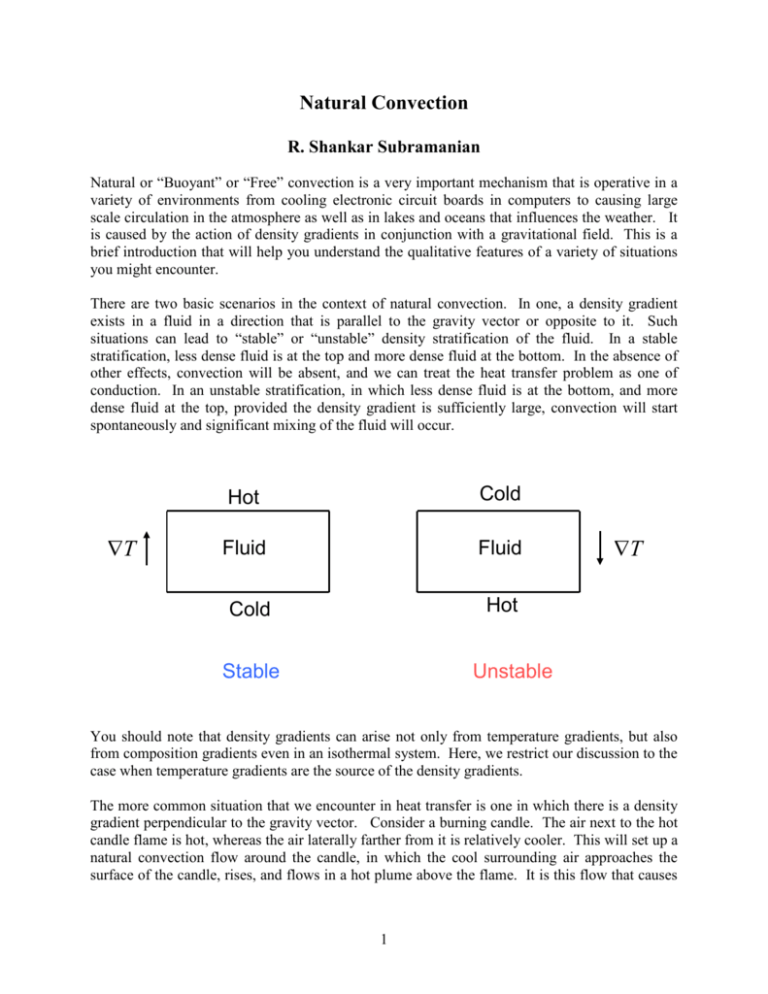
Natural Convection R. Shankar Subramanian Natural or “Buoyant” or “Free” convection is a very important mechanism that is operative in a variety of environments from cooling electronic circuit boards in computers to causing large scale circulation in the atmosphere as well as in lakes and oceans that influences the weather. It is caused by the action of density gradients in conjunction with a gravitational field. This is a brief introduction that will help you understand the qualitative features of a variety of situations you might encounter. There are two basic scenarios in the context of natural convection. In one, a density gradient exists in a fluid in a direction that is parallel to the gravity vector or opposite to it. Such situations can lead to “stable” or “unstable” density stratification of the fluid. In a stable stratification, less dense fluid is at the top and more dense fluid at the bottom. In the absence of other effects, convection will be absent, and we can treat the heat transfer problem as one of conduction. In an unstable stratification, in which less dense fluid is at the bottom, and more dense fluid at the top, provided the density gradient is sufficiently large, convection will start spontaneously and significant mixing of the fluid will occur. ∇T Hot Cold Fluid Fluid Cold Hot Stable ∇T Unstable You should note that density gradients can arise not only from temperature gradients, but also from composition gradients even in an isothermal system. Here, we restrict our discussion to the case when temperature gradients are the source of the density gradients. The more common situation that we encounter in heat transfer is one in which there is a density gradient perpendicular to the gravity vector. Consider a burning candle. The air next to the hot candle flame is hot, whereas the air laterally farther from it is relatively cooler. This will set up a natural convection flow around the candle, in which the cool surrounding air approaches the surface of the candle, rises, and flows in a hot plume above the flame. It is this flow that causes 1 the visible flame to take the shape it does. In the absence of gravity, a candle flame would be spherical. Another example is the flow of air at the tip of a lit cigarette; in this case, the smoke from the cigarette actually traces that flow for us. In a common technique used for home heating, the baseboard heater consists of a tube through which hot water flows, and the heater is placed close to the floor. The tube is outfitted with fins to provide additional heat transfer surface. The neighboring air is heated, and the hot air rises, with cooler air moving in toward the baseboard at floor level. This natural convection circulation set up by the hot baseboard provides a simple mixing mechanism for the air in the room and helps us maintain a relatively uniform temperature everywhere. Clearly, the convection helps the heat transfer process here. Natural Convection adjacent to a heated vertical surface Consider a hot vertical surface present in a fluid. The surface is maintained at a temperature Ts , which is larger than the ambient temperature in the fluid Te . Here is a sketch of the momentum boundary layer along the plate. δm Ts Te As shown in the sketch, the cold fluid rises along the plate surface, becoming heated in the process, and the momentum boundary layer grows in thickness with distance along the plate. A sample velocity profile in the momentum boundary layer is shown. Note that in this type of boundary layer, the velocity must be zero not only at the solid surface, but also at the edge of the boundary layer. Because the profile was sketched free-hand in PowerPoint, I am unable to show the smooth approach to zero velocity with a zero slope at the edge of the boundary layer properly, but that is how the correct velocity profile would appear. Compare this velocity profile with that in a momentum boundary layer that forms on a flat plate when fluid approaches it with a uniform velocity U ∞ . You should try to make a sketch of the thermal boundary layer on the same plate when the fluid is air, for example, and also when it is a viscous liquid with a Prandtl number that is large compared with unity. 2 Now, let us consider a typical window in a home on a winter day when the outside air is at 10 F and the inside of the room is at a balmy 68 F . What will the momentum boundary layers on either side of the window look like? Try to sketch them yourself before looking at the sketch. The arrows in the sketch show the direction of air flow at the location where the air enters the boundary layer on the inside as well as on the outside, and the direction of air flow within the boundary layer. There is a slight transverse flow in each boundary layer, but on the scale of the picture, it is difficult to use the arrows to show it; therefore, I have drawn the flow in the boundary layers as being vertically downward or upward as appropriate. δm δm What will the thermal boundary layers look like? Try sketching them. Also, you should make a sketch of the temperature distribution along the interior and exterior surfaces of the window from the bottom to the top. Will this permit you to explain why ice forms in a certain pattern on the outside surface of a window on really cold nights? The Grashof and Rayleigh Numbers In natural convection situations, an important dimensionless group is the Grashof number. To provide some physical significance to this group prior to defining it, we use a simple order of magnitude estimate of the natural convection velocity in the above examples. When fluid with a 1 density ρ moves at a velocity V , the kinetic energy per unit volume can be written as ρV 2 . 2 This must come from some other form of energy, namely, potential energy lost by the fluid. Over a vertical distance L , the difference in potential energy between the less dense fluid in the 3 boundary layer and the more dense fluid outside it can be approximately expressed as g ∆ρ L , where g is the magnitude of the acceleration due to gravity, and ∆ρ is a characteristic density difference between the boundary layer fluid and that far away. We can equate these two order of magnitude estimates, and neglect the factor of 1/ 2 , because this is only an order of magnitude analysis. ρ V 2 ≈ g ∆ρ L Therefore, a typical order of magnitude of the velocity arising from natural convection is V≈ ∆ρ ρ gL Let us define a Reynolds number for the flowing fluid using this order of magnitude estimate. ∆ρ g L3 ρ ν ν2 ∆ρ g L3 ρ so that Re 2L = . This is a dimensionless group that occurs often in natural convection ν2 = Re L LV = problems, and is given the name Grashof Number, abbreviated as Gr. ∆ρ Gr = g L3 ρ ν2 The coefficient of volumetric expansion of a fluid β is defined as ∂ 1 1 ∂V 1 ∂ρ where V is the specific volume, T = ρ = − ∂T ρ p V ∂T P ρ ∂T P temperature of the fluid and P is its pressure. Therefore, we can write β= ∆ρ is the ∆T ∂ρ = − = β ∆T where we have used a minus sign in relating ∆ ρ to ∆T because ρ ρ ∂T p both are defined as being positive, and as temperature increases, density decreases. We can finally rewrite the definition of the Grashof number as follows. Gr = β ∆T g L3 ν2 4 The Grashof number is related to the Reynolds number, and in heat transfer, the Prandtl number plays a significant role. Therefore, in natural convection heat transfer, we encounter another dimensionless group, called the Rayleigh number, abbreviated by Ra , which is the product of the Grashof and Prandtl numbers. Ra = Gr × Pr = β ∆T g L3 να Here, α is the thermal diffusivity of the fluid. The Nusselt number in natural convection heat transfer situations is typically a function of the Rayleigh number, the Prandtl number, and aspect ratio parameters. For a vertical heated plate of length L , Mills (1) suggests using the following correlation for the h L average Nusselt Number, Nuaverage = average (where k is the thermal conductivity of the fluid). k 0.68 0.670 ( Ra Ψ ) Nuaverage =+ , Nuaverage = 0.68 + 0.670 ( Ra Ψ ) (1 + 1.6 × 10 1/ 4 1/ 4 Ra ≤ 109 −8 Ra Ψ ) 1/12 , 109 ≤ Ra < 1012 In these equations Ψ is a function of the Prandtl number, defined as follows. 16 / 9 Ψ= 0.492 9 /16 1 + Pr The reason for changing from one correlation to another when the Rayleigh number exceeds 109 is that the natural convection boundary layer undergoes transition to turbulence around that value of the Rayleigh number. Mills points out that at Ra = 109 the above two correlations do not coincide in their predictions. This is fine, because that value of the Rayleigh number is an arbitrary cross-over point from one correlation to the other. It is fine to use the second (turbulent) correlation for Ra = 109 . As usual, physical properties should be evaluated at the arithmetic average temperature between the plate and the ambient fluid. Other natural convection flows Mills recommends suitable correlations for natural convection flow over a horizontal heated cylinder and a heated sphere. For other objects of arbitrary shape, he recommends a correlation due to Lienhard. 5 Nuaverage = 0.52 Ra1/ 4 Here the length L to be used in both the Nusselt and Rayleigh numbers is the length of the boundary layer; for example, L = π R for a cylinder or sphere of radius R . But for those two geometries it is better to use the specific correlations given in the textbook by Mills. Mills also provides some useful correlations for natural convection in enclosures. Windows used in homes are termed “single-pane” or “thermopane.” A single pane window is a glass plate that separates the inside of a room from the outside. Heat transfer between the indoor air and the air outside occurs by conduction through the glass, and the heat transfer rate can be large. Therefore, the “thermopane” window was designed to reduce the heat loss by using two glass plates with a small gap between them. Let us assume the gap is filled with air, and for the sake of simplicity, that the plates are wide and long, and are each maintained at a uniform temperature. The sketch given below is taken from a textbook by Bird et al. (2); it depicts the temperature distribution between the two plates and the resulting natural convection velocity distribution. Note that even though there is convection in the air, it does not influence the heat flux through the air gap, because the temperature distribution still remains linear at this order of approximation. The air gap significantly increases the thermal resistance of the window and reduces the heat flux between the outside air and that inside the room. In modern thermopane windows, the gap between the two plates is evacuated, so that the heat transfer rate is further reduced, at least initially when the window is new. Over time, air leaks through the seals into the gap, increasing heat loss in the winter and heat gain in the summer. It is worth noting that as the gap width is increased, the velocity in the gap increases proportionally to the cube of the gap width. At larger gap widths, the temperature profile is no longer linear, and the convection actually increases the heat flux through the gap over that occurring due to pure conduction. This is the reason for the choice of a small width of the order of 1-2 mm for the air gap in thermopane windows. 6 If you wish to learn more about natural convection heat transfer, a good reference is the book by Gebhart et al. (3). References 1. Mills, A.F., Heat Transfer, Prentice-Hall, New Jersey (1999). 2. Bird, R.B., Stewart, W.E., and Lightfoot, E.N., Transport Phenomena, Wiley, New York 2007). 3.Gebhart, B., Jaluria, Y., Mahajan, R.L., and Sammakia, B., Buoyancy-Induced Flows and Transport, Hemisphere, Cambridge (1988). 7

